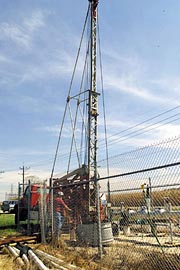
Now we run into the “how” part. There are many opinions and conflicting views: What chemicals to use? What development method? How long to work it? How to evaluate? The chemical part is particularly confusing with various blends now on the market. Some of these make extraordinary claims. Their actual performance under varying circumstances needs to be validated, and their chemical mode of action made known. Otherwise, I do not see how a driller can make an objective decision for a particular job.
We do know that it is possible to specify a blend for a specific known problem need (for example, iron biofouling in a tight sand formation). These can be specified based on simple, but effective testing. As for the chemicals, this grizzled old vet in well rehab planning and research personally advises caution and specifying chemical blends by generic name and quantity (so much acetic, amended by so much sulfamic in so much water, etc.). If the name-brand blend meets those specific qualifications, fine. Don't buy on sales pitch alone.
Then we have old reliables: “I have always used two carloads of muriatic in all my wells. If the grout can't take the pressure, that's just too bad. They need to drill another well.” I exaggerate, of course (don't I?). The time has really come for those who have done it the same old way forever to take a look at alternatives. We do know that muriatic and chlorine are not the answer to everything. There are less dangerous and more effective ways to deal with iron biofouling, for example. We do know that phosphate-containing additives are prone to encourage regrowth and that it is very difficult to remove them totally (and it doesn't take much to restart a clogging biofilm that can then sustain itself). We do know that chlorinating afterward is not the antidote to putting essential nutrients in the hole.
We do know that rehabbing plume control and pumping wells requires another level of caution, consideration and expertise. The chemical tool kit is much smaller (in the case of the ASTM Standard Guide for monitoring well maintenance, there is no toolkit). The results less certain. The possibility of failure is higher.
It seems sometimes that less thought and expertise is going into these projects than should be the case. The reason is a lack of foresight about the difficulty of the operating conditions of these types of wells in budgeting and planning for their operation, including material selection and even basic well design.
We do know that all well rehab requires time, patience and effective development motion to work. Many methods work very well under specific circumstances: Sonar Jet, AquaFreed, and conventional surging and jetting (done intelligently). For many local situations, I am personally a fan of the cable tool rig with air compressor for workover purposes. With proper tools, air amendment, etc., you have all you really need: a hoist, an effective means of forcing an in-and-out motion, a slurry pumping system (various bailers plus airlift), all at relatively low hourly cost. It is not the only effective system, but I suggest that you rotary hotrods should not let the old 22W rust away just yet. This can be new life for it.
We also know that rehabilitation is only the start of recovery for the rehabbed well. The tendency is to get it back in operation and then go on. The actual thing to do is to plan for when the deteriorating conditions will return. We know they will.
We know from study and experience that maintenance monitoring and preventive treatment is both effective and less costly than waiting for failure and rehabbing again. This can be a service opportunity for many contractors. It is this maintenance that will keep the well operating far into the future.
We do not know the full answer to the economics of well rehabilitation and maintenance. The last nationwide economic study of rehabilitation processes was done in 1960 in the United States. The relative economics of maintenance as a policy versus crisis-reaction management are developing based on studies by colleagues of mine in England. From that, we are confident to a high degree of certainty that a maintenance policy saves a lot of money over a wellfield life cycle. Perhaps more valuable information will be coming in the near future.
We do not have a one-size-fits-all recommendation (would you expect one?) because each well situation is different. What we do know is that with testing and careful planning and competent execution that effective well rehab is possible. We do know that it must be followed by a maintenance program or the rehab is a total waste of money. Both testing and the maintenance are doable by any competent driller and water treatment or remediation treatment plant operator with the right knowledge.
So go deeper, dear reader. Go past the fiery sales preaching and graphical glitz and study the scriptures: the available literature on well maintenance and rehabilitation is there for all to read.
ND


Report Abusive Comment